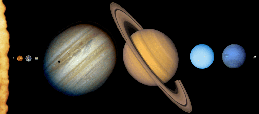
-
Prof: Doug Hamilton
Phone: (301) 405-1548
Email: hamilton@astro.umd.edu
Office: CSS 1245
Office Hours: Drop by Anytime!
Textbook: Planetary Sciences by I. de Pater and J.J. Lissauer
Webpage: http://www.astro.umd.edu/~hamilton/ASTR630

This course will survey the science of our planetary system with an emphasis on those aspects that help us understand its origin and connection to other planetary systems. According to the authors, the amount of material in the textbook "is difficult to cover in a one year graduate-level course", so we will choose topics selectively to fit into one semester. Given that we will be covering a lot of material in a short amount of time, students will get the most out of class lectures if they read and think about the relevant book chapters before we cover them in class. All material from the chapters that we cover is fair game for tests.
Topics to be covered in the first half of the course include orbital dynamics, the physics of planetary atmospheres, and radiative transfer (chapters 1-4). We will emphasize techniques of problem solving and will focus a number of topics including the three body problem, orbital resonances, hydrostatic equilibrium, equations of state, thermal structure of an atmosphere, and winds..
Due to time pressures, the second half of the course will focus on four additional chapters of the book selected by students. Some possible combinations include i) planetary surfaces and interiors, asteroids, and meteorites (taught in Fall 2004) and magnetospheres, planetary rings, extrasolar planets, and planetary formation (taught in Fall 2010). The syllabus will be maintained online, and will be updated frequently as the semester progresses. It may be necessary to drop one or more lectures to better cover other topics.
Students should expect an in-class midterm and a final exam, and five homework assignments, largely but not exclusively drawn from the text. There will also be a class project with an oral presentation due toward the end of the semester.
 Return
to ASTR630 Home Page
Return
to ASTR630 Home Page